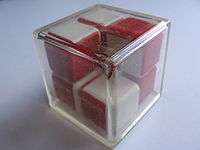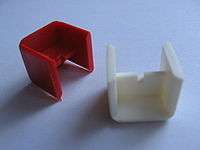Minus Cube


The Minus Cube (Russian: «Минус-кубик») is a 3D mechanical variant of the n-puzzle which was manufactured in the Soviet Union. It consists of a bonded transparent plastic box containing seven small cubes, each glued together from two U-shape parts: one white and one coloured. The length of one side of the interior of the box is slightly more than twice the length of the side of a small cube. There is an empty space the size of one small cube inside the box and the small cubes are moveable inside the box by tilting the box causing a cube to fall into the space. The goal of the puzzle is to shuffle the cubes in such a way that on each side of the box, all of the faces of the small cubes are one color.
There were two types of Minus Cubes manufactured: the so-called "Moscow Minus Cube" (red-white) and "Sverdlovsk Minus Cube" (blue-white), each named after the cities in which they were produced. They differed only in the orientation of one of the small cubes. Because of this difference there are 12 times as many "solved" arrangements for the Moscow Minus Cube, and thus the Sverdlovsk Minus Cube is 12 times more difficult to solve. However, if one does not confine oneself to these two types of the Minus Cube, there are 48 Minus Cube variants which can be solved.
See also
References
- (Russian) An article on the Minus Cube in Kvant magazine 1988, N6, p.66
External links
- Minus Cube Puzzle at TwistyPuzzles.com
- A photo of Sverdlovsk Minus Cube Puzzle
- "Varikon Box 2×2×2 / The Minus Cube". Jaap. Retrieved 2016-01-13.